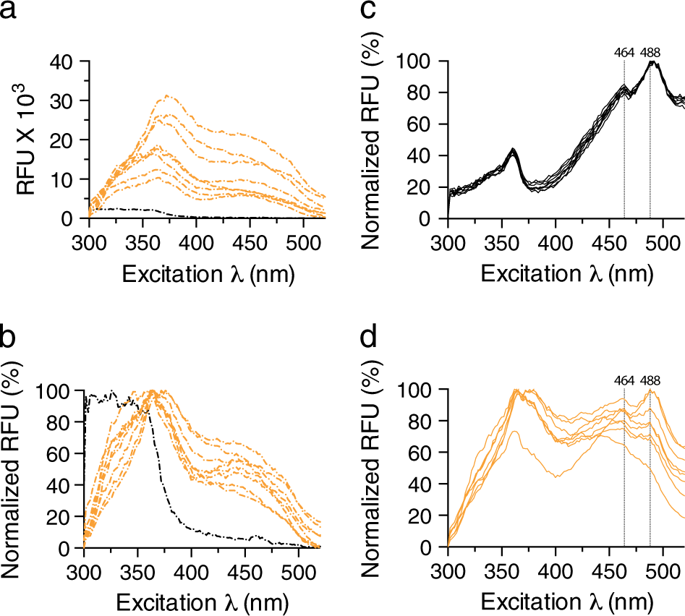npj Biofilms and Microbiomes ( IF 9.2 ) Pub Date : 2018-10-26 , DOI: 10.1038/s41522-018-0069-y Haris Antypas , Ferdinand X. Choong , Ben Libberton , Annelie Brauner , Agneta Richter-Dahlfors

|
The ability of uropathogenic Escherichia coli (UPEC) to adopt a biofilm lifestyle in the urinary tract is suggested as one cause of recurrent urinary tract infections (UTIs). A clinical role of UPEC biofilm is further supported by the presence of bacterial aggregates in urine of UTI patients. Yet, no diagnostics exist to differentiate between the planktonic and biofilm lifestyle of bacteria. Here, we developed a rapid diagnostic assay for biofilm-related UTI, based on the detection of cellulose in urine. Cellulose, a component of biofilm extracellular matrix, is detected by a luminescent-conjugated oligothiophene, which emits a conformation-dependent fluorescence spectrum when bound to a target molecule. We first defined the cellulose-specific spectral signature in the extracellular matrix of UPEC biofilm colonies, and used these settings to detect cellulose in urine. To translate this optotracing assay for clinical use, we composed a workflow that enabled rapid isolation of urine sediment and screening for the presence of UPEC-derived cellulose in <45 min. Using multivariate analysis, we analyzed spectral information obtained between 464 and 508 nm by optotracing of urine from 182 UTI patients and 8 healthy volunteers. Cellulose was detected in 14.8% of UTI urine samples. Using cellulose as a biomarker for biofilm-related UTI, our data provide direct evidence that UPEC forms biofilm in the urinary tract. Clinical implementation of this rapid, non-invasive and user-friendly optotracing diagnostic assay will potentially aid clinicians in the design of effective antibiotic treatment.
中文翻译:

快速诊断测定法可检测尿液中的纤维素,作为生物膜相关尿路感染的生物标志物
尿路致病性大肠杆菌的能力(UPEC)建议在尿道中采用生物膜生活方式是复发性尿路感染(UTI)的原因之一。UTEC患者尿液中存在细菌聚集体,进一步支持了UPEC生物膜的临床作用。但是,尚无诊断方法可区分细菌的浮游生物和生物膜生活方式。在这里,我们基于尿液中纤维素的检测,开发了针对生物膜相关性尿路感染的快速诊断检测方法。纤维素是生物膜细胞外基质的一个组成部分,可通过发光共轭寡聚噻吩进行检测,该寡聚噻吩在与目标分子结合后会发出构象依赖性荧光光谱。我们首先在UPEC生物膜菌落的细胞外基质中定义了纤维素特异性的光谱特征,并使用这些设置来检测尿液中的纤维素。为了将这种光示踪测定法转化为临床用途,我们组成了一个工作流程,该流程能够在不到45分钟的时间内快速分离尿沉渣并筛选UPEC衍生纤维素的存在。使用多变量分析,我们分析了来自182名UTI患者和8名健康志愿者的尿液的光描迹,获得了464 nm至508 nm之间的光谱信息。在14.8%的UTI尿液样本中检测到纤维素。使用纤维素作为生物膜相关尿路感染的生物标志物,我们的数据提供了直接证据,表明UPEC在尿道中形成生物膜。这种快速,无创且用户友好的光跟踪诊断检测方法的临床实施将有可能帮助临床医生设计有效的抗生素治疗方法。我们组成了一个工作流程,可以在不到45分钟的时间内快速分离出尿液沉积物并筛选出UPEC衍生纤维素的存在。使用多变量分析,我们分析了来自182名UTI患者和8名健康志愿者的尿液的光描迹,获得了464 nm至508 nm之间的光谱信息。在14.8%的UTI尿液样本中检测到纤维素。使用纤维素作为生物膜相关尿路感染的生物标志物,我们的数据提供了直接证据,表明UPEC在尿道中形成生物膜。这种快速,无创且用户友好的光跟踪诊断检测方法的临床实施将有可能帮助临床医生设计有效的抗生素治疗方法。我们组成了一个工作流程,可以在不到45分钟的时间内快速分离出尿液沉积物并筛选出UPEC衍生纤维素的存在。使用多变量分析,我们分析了来自182名UTI患者和8名健康志愿者的尿液的光描迹,获得了464 nm至508 nm之间的光谱信息。在14.8%的UTI尿液样本中检测到纤维素。使用纤维素作为生物膜相关尿路感染的生物标志物,我们的数据提供了直接证据,表明UPEC在尿道中形成生物膜。这种快速,无创且用户友好的光跟踪诊断检测方法的临床实施将有可能帮助临床医生设计有效的抗生素治疗方法。我们分析了来自182名UTI患者和8名健康志愿者的尿液的光描迹,获得了464 nm至508 nm之间的光谱信息。在14.8%的UTI尿液样本中检测到纤维素。使用纤维素作为生物膜相关尿路感染的生物标志物,我们的数据提供了直接证据,表明UPEC在尿道中形成生物膜。这种快速,无创且用户友好的光跟踪诊断检测方法的临床实施将有可能帮助临床医生设计有效的抗生素治疗方法。我们分析了来自182名UTI患者和8名健康志愿者的尿液的光描迹,获得了464 nm至508 nm之间的光谱信息。在14.8%的UTI尿液样本中检测到纤维素。使用纤维素作为生物膜相关尿路感染的生物标志物,我们的数据提供了直接证据,表明UPEC在尿道中形成生物膜。这种快速,无创且用户友好的光跟踪诊断检测方法的临床实施将有可能帮助临床医生设计有效的抗生素治疗方法。



























 京公网安备 11010802027423号
京公网安备 11010802027423号